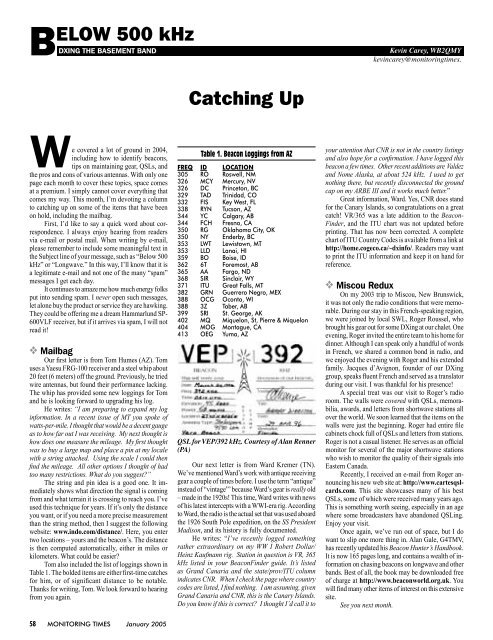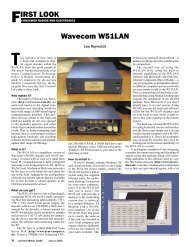MT Express Sample Low Resolution Issue ... - Monitoring Times
MT Express Sample Low Resolution Issue ... - Monitoring Times
MT Express Sample Low Resolution Issue ... - Monitoring Times
Create successful ePaper yourself
Turn your PDF publications into a flip-book with our unique Google optimized e-Paper software.
BELOW 500 kHz<br />
DXING THE BASEMENT BAND<br />
Kevin Carey, WB2QMY<br />
kevincarey@monitoringtimes.<br />
Catching Up<br />
We covered a lot of ground in 2004,<br />
including how to identify beacons,<br />
tips on maintaining gear, QSLs, and<br />
the pros and cons of various antennas. With only one<br />
page each month to cover these topics, space comes<br />
at a premium. I simply cannot cover everything that<br />
comes my way. This month, I’m devoting a column<br />
to catching up on some of the items that have been<br />
on hold, including the mailbag.<br />
First, I’d like to say a quick word about correspondence.<br />
I always enjoy hearing from readers<br />
via e-mail or postal mail. When writing by e-mail,<br />
please remember to include some meaningful text in<br />
the Subject line of your message, such as “Below 500<br />
kHz” or “Longwave.” In this way, I’ll know that it is<br />
a legitimate e-mail and not one of the many “spam”<br />
messages I get each day.<br />
It continues to amaze me how much energy folks<br />
put into sending spam. I never open such messages,<br />
let alone buy the product or service they are hawking.<br />
They could be offering me a dream Hammarlund SP-<br />
600VLF receiver, but if it arrives via spam, I will not<br />
read it!<br />
❖ Mailbag<br />
Our first letter is from Tom Humes (AZ). Tom<br />
uses a Yaesu FRG-100 receiver and a steel whip about<br />
20 feet (6 meters) off the ground. Previously, he tried<br />
wire antennas, but found their performance lacking.<br />
The whip has provided some new loggings for Tom<br />
and he is looking forward to upgrading his log.<br />
He writes: “I am preparing to expand my log<br />
information. In a recent issue of <strong>MT</strong> you spoke of<br />
watts-per-mile. I thought that would be a decent gauge<br />
as to how far out I was receiving. My next thought is<br />
how does one measure the mileage. My first thought<br />
was to buy a large map and place a pin at my locale<br />
with a string attached. Using the scale I could then<br />
find the mileage. All other options I thought of had<br />
too many restrictions. What do you suggest?”<br />
The string and pin idea is a good one. It immediately<br />
shows what direction the signal is coming<br />
from and what terrain it is crossing to reach you. I’ve<br />
used this technique for years. If it’s only the distance<br />
you want, or if you need a more precise measurement<br />
than the string method, then I suggest the following<br />
website: www.indo.com/distance/. Here, you enter<br />
two locations – yours and the beacon’s. The distance<br />
is then computed automatically, either in miles or<br />
kilometers. What could be easier?<br />
Tom also included the list of loggings shown in<br />
Table 1. The bolded items are either first-time catches<br />
for him, or of significant distance to be notable.<br />
Thanks for writing, Tom. We look forward to hearing<br />
from you again.<br />
Table 1. Beacon Loggings from AZ<br />
FREQ ID LOCATION<br />
305 RO Roswell, NM<br />
326 MCY Mercury, NV<br />
326 DC Princeton, BC<br />
329 TAD Trinidad, CO<br />
332 FIS Key West, FL<br />
338 RYN Tucson, AZ<br />
344 YC Calgary, AB<br />
344 FCH Fresno, CA<br />
350 RG Oklahoma City, OK<br />
350 NY Enderby, BC<br />
353 LWT Lewistown, <strong>MT</strong><br />
353 LLD Lanai, HI<br />
359 BO Boise, ID<br />
362 6T Foremost, AB<br />
365 AA Fargo, ND<br />
368 SIR Sinclair, WY<br />
371 ITU Great Falls, <strong>MT</strong><br />
382 GRN Guerrero Negro, MEX<br />
388 OCG Oconto, WI<br />
388 3Z Taber, AB<br />
399 SRI St. George, AK<br />
402 MQ Miquelon, St, Pierre & Miquelon<br />
404 MOG Montague, CA<br />
413 OEG Yuma, AZ<br />
QSL for VEP/392 kHz. Courtesy of Alan Renner<br />
(PA)<br />
Our next letter is from Ward Kremer (TN).<br />
We’ve mentioned Ward’s work with antique receiving<br />
gear a couple of times before. I use the term “antique”<br />
instead of “vintage”’ because Ward’s gear is really old<br />
– made in the 1920s! This time, Ward writes with news<br />
of his latest intercepts with a WWI-era rig. According<br />
to Ward, the radio is the actual set that was used aboard<br />
the 1926 South Pole expedition, on the SS President<br />
Madison, and its history is fully documented.<br />
He writes: “I’ve recently logged something<br />
rather extraordinary on my WW I Robert Dollar/<br />
Heinz Kaufmann rig. Station in question is VR, 365<br />
kHz listed in your BeaconFinder guide. It’s listed<br />
as Grand Canaria and the state/prov/ITU column<br />
indicates CNR. When I check the page where country<br />
codes are listed, I find nothing. I am assuming, given<br />
Grand Canaria and CNR, this is the Canary Islands.<br />
Do you know if this is correct? I thought I’d call it to<br />
your attention that CNR is not in the country listings<br />
and also hope for a confirmation. I have logged this<br />
beacon a few times. Other recent additions are Valdez<br />
and Nome Alaska, at about 524 kHz. I used to get<br />
nothing there, but recently disconnected the ground<br />
cap on my ARBE III and it works much better.”<br />
Great information, Ward. Yes, CNR does stand<br />
for the Canary Islands, so congratulations on a great<br />
catch! VR/365 was a late addition to the Beacon-<br />
Finder, and the ITU chart was not updated before<br />
printing. That has now been corrected. A complete<br />
chart of ITU Country Codes is available from a link at<br />
http://home.cogeco.ca/~dxinfo/. Readers may want<br />
to print the ITU information and keep it on hand for<br />
reference.<br />
❖ Miscou Redux<br />
On my 2003 trip to Miscou, New Brunswick,<br />
it was not only the radio conditions that were memorable.<br />
During our stay in this French-speaking region,<br />
we were joined by local SWL, Roger Roussel, who<br />
brought his gear out for some DXing at our chalet. One<br />
evening, Roger invited the entire team to his home for<br />
dinner. Although I can speak only a handful of words<br />
in French, we shared a common bond in radio, and<br />
we enjoyed the evening with Roger and his extended<br />
family. Jacques d’Avignon, founder of our DXing<br />
group, speaks fluent French and served as a translator<br />
during our visit. I was thankful for his presence!<br />
A special treat was our visit to Roger’s radio<br />
room. The walls were covered with QSLs, memorabilia,<br />
awards, and letters from shortwave stations all<br />
over the world. We soon learned that the items on the<br />
walls were just the beginning. Roger had entire file<br />
cabinets chock full of QSLs and letters from stations.<br />
Roger is not a casual listener. He serves as an official<br />
monitor for several of the major shortwave stations<br />
who wish to monitor the quality of their signals into<br />
Eastern Canada.<br />
Recently, I received an e-mail from Roger announcing<br />
his new web site at: http://www.cartesqslcards.com.<br />
This site showcases many of his best<br />
QSLs, some of which were received many years ago.<br />
This is something worth seeing, especially in an age<br />
where some broadcasters have abandoned QSLing.<br />
Enjoy your visit.<br />
Once again, we’ve run out of space, but I do<br />
want to slip one more thing in. Alan Gale, G4TMV,<br />
has recently updated his Beacon Hunter’s Handbook.<br />
It is now 165 pages long, and contains a wealth of information<br />
on chasing beacons on longwave and other<br />
bands. Best of all, the book may be downloaded free<br />
of charge at http://www.beaconworld.org.uk. You<br />
will find many other items of interest on this extensive<br />
site.<br />
See you next month.<br />
58 MONITORING TIMES January 2005
















